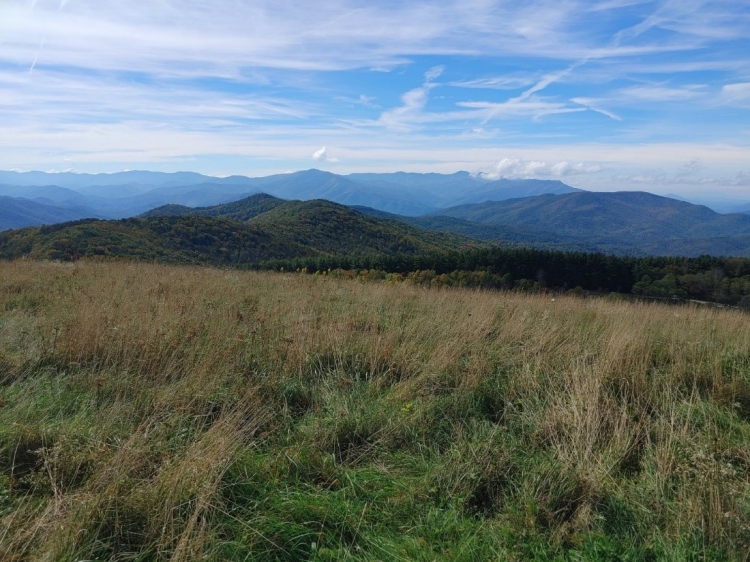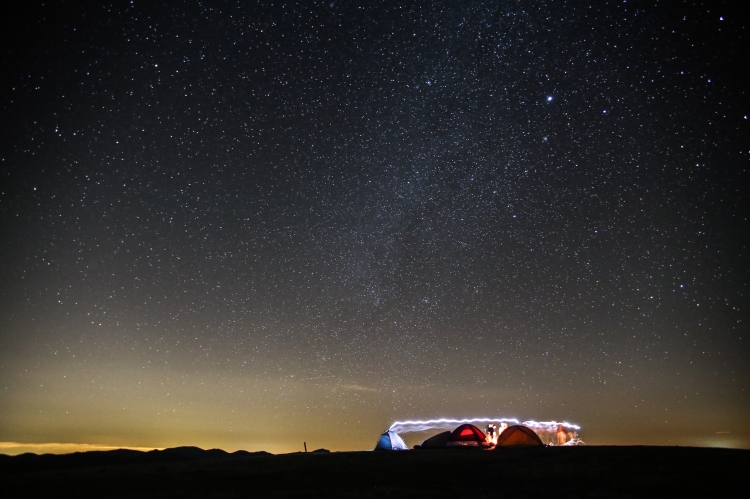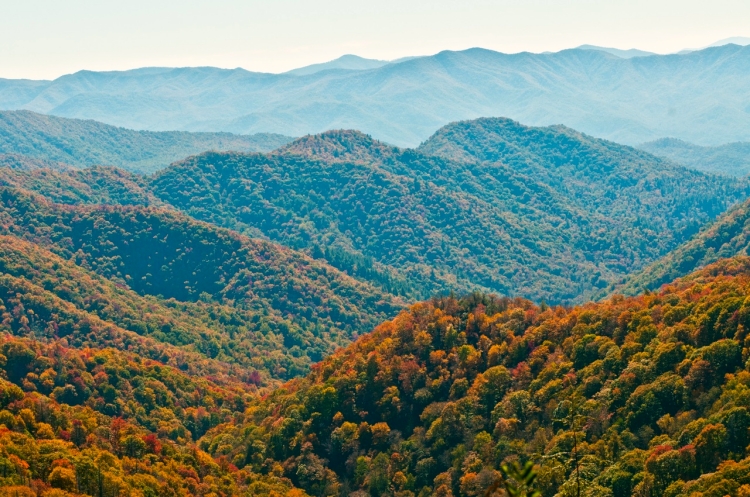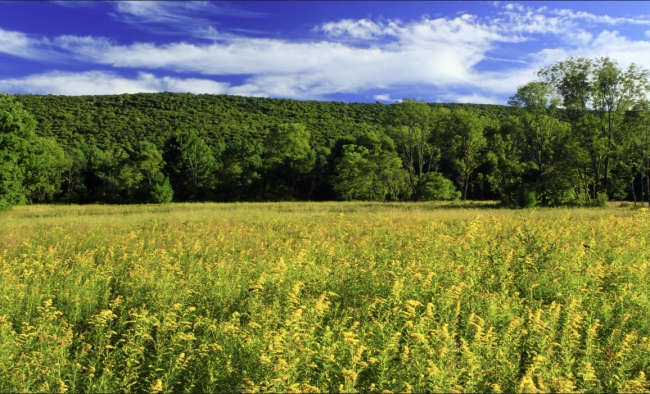“I want to walk with Dada,” Eli announces.
I smile to myself when I hear his little six-year-old voice. On this October day, a clear, expansive sky spreads across the land. My boy runs to me and takes my hand. Tall grass, gradually fading to brown in the autumn season, sways behind the breeze of his footsteps.
“Aw. I want to walk with Dada,” his granny repeats with a kind grin.
She chuckles and says something to Katie, who laughs along with her mom.
We are on our way to Max Patch for an overnighter along the North Carolina-Tennessee border. Our small hike will take us out of a forested ecosystem to an open Southern Appalachian bald in Pisgah National Forest. Once we crest our short hike, we will stand taller than the trees.

I carry an extra-large pack stuffed and tied with sleeping bags, blankets, leftovers, a couple of tents, and a box of red wine for good measure.
“Why don’t we all just stick together?” I call back over my shoulder. The small bits of stone on our path crunch underneath my boots as we stroll along the left leading trail to the summit. “We’re in no rush at all. We’ve all night up here.”
I look toward the toothed margins of rustling leaves. They’re early in their color change, yet radiant enough to pop and dance in the light of a low hanging sun against a cerulean blue sky.
“Oh, no,” Granny sighs, “with my bad knee it will take me a while to climb. You’ll both have a better time moving ahead.”
“Go for it you two,” Katie adds. “I’ll stay behind and walk up with Granny.”
The boy and I cordially agree and pick up our pace to the 35-acre tract of land that boasts unimpeded views of the great Appalachian Mountain Range. Clocking in at around 4,600 feet above sea level, the patch offers a panoramic vision of the true magnitude of these timeless mountains.
Our hike is short and easy, but, with the heavy pack and a slight uphill trek, my heart rate still speeds up enough to warrant a break or two on our journey. Eli welcomes the small pauses as well. Our dogs, old sweetie Sierra and youthful disaster Coors, are along for our trip.
“That’s a good boy,” Eli coos as he pets his puppy.
In turn, I look down to Sierra and wink as she looks up at me happily wagging her tail with twinkling excitement in her eyes. We stand in a grove of beech trees, their colors advancing with each passing autumn night. As the darkness becomes longer and time under the sun shorter, biochemicals in these leaves continually paint the landscape in a mosaic of autumnal palette. I enjoy these trees and their spotted yellow hue, but the awaiting panoramic calls, and I want to get our camp and sleeping arrangements set up with the boy before Katie and Granny reach the grassy summit.
The day is Thursday, October 8, in this crazy year of 2020. Tonight, though, is sure to be special. Our college’s fall break occurs on Monday and Tuesday of the following week. Just so happens, Katie and I have no teaching responsibilities this Friday, so we ran out of Knoxville a day early to start our break.
The family and I have been coming to Max Patch for the past six years. The voyage has become a tradition for us over fall break. During our time off, we leisure in the neighboring town of Hot Springs, North Carolina. We always rent ourselves a primitive cabin – cabin number one to be exact – from the resort and spa in town to pass a few splendid days in the middle of October. We spend a few hours out here on the Patch during these trips to picnic and take in the views. A couple of years ago, we invited a host of folks along for our annual vacation and were able to get Granny on top of this spot for the first time. She instantly fell for the special place. After that trip, Granny let Katie know something she had on her bucket list: She’d like to spend a night on the bald underneath a moonlit sky. Tonight, she can cross that off her list.

Easy to understand why this place grabbed her. Max Patch is among the most memorable spots on the Appalachian Trail. The highland meadow offers a grand reward for very little labor. Back in the 1800s, yeoman brought cattle and sheep to graze the grasses on this spot here on the mountain. If left to nature, ecological succession would eventually fill in the highland meadow. Shrubs would grow then give way to pines. Eventually, mixed hardwoods would cover the patch. To this day, control burns, and routine mows keep this stretch of land home to a small population of rattle snakes, birds, and tiny mammals, a bald.
In the early 1900s, the bald served as the highest airplane landing strip east of the Mississippi River. Daredevil air shows were held out here in the 1920s and 30s. During the Second World War, and in subsequent post war times, the bald was used intermittently by locals since the Patch was largely unnoticed. By the early 1980s, however, developers eyeballed the space for a ski resort. This proposition, of course, was not popular with folks who lived near the area. With the help of conservation organizations, the surrounding community reached out to the United States Forest Service for help. In 1982 their wishes were granted. The Patch was officially adopted into Pisgah National Forest, thus saving the space and the spectacular views from development.
Eli and I find ourselves on the bald a decent bit before Katie and Granny. Looking around, we happily realize we have only a few neighbors up on the bald tonight. Even better, we are all so spread out we’ll never notice anyone.
On the summit, the sky is as big as it feels – cosmic. Out here, I find it very easy to understand we are simply a planetary species floating along on a blue rock in interstellar space. We’re made of ions, atoms, molecules – the products of dust and cosmic rays. The pink, purple, blue, and hints of grey mountains are all around in a whimsical view. From here, these Appalachian Mountains appear almost like rippled ocean waves moving toward the eternity of our universal existence.

I cannot help but feel happy and relaxed out here. Eli giggles as he plays with our dog Coors in the meadow grass. The cool whispers of autumn wind move the grassy bald. As the boy plays, the rustled grass and his laughter meet to ring and clang in the air like natural wind chimes – such a rare and beautiful racket of natural formless music pouring through the mountain. I love my boy. He’s struggled over the past few months, but damn does he have an incredible spirit. As for the dogs, we’ve tied the young pup to a lead. I always let Sierra, a good veteran pup, loose to wander. I simply whistle to call her back. At ten years old, she still loves to explore.
Our tents are all set up, camping pads, and sleeping bags all tucked in and cozy, when Katie and Granny arrive. As our sun-soaked evening progresses, though, bands of clouds build low across the horizon. We may not see the starlight after all. With about an hour or so before the sun sets, the clouds appear to accumulate quickly. The floating phantoms do not disappoint, though. They stretch across the sky as flaming orange and ash grey puffs that accent and mosaic the sprawling mountains. The sun, though, shines bright among the grasses dancing in their own shadows. Goldenrod blooms and paints an ornate golden flame across our meadow. The beech trees seem to rattle in the wind. All these hues celebrate each other and belong together.

Autumn is a time of hues – the last burn of the temperate zone before winter comes. At the autumn equinox, the days continually grow shorter as dark nights grow longer. The growing season turns to the harvest. As autumn is equated with dying, winter is equated with death. I’ve never really thought this common analogy was totally fair. Autumn is the season of dying and death – but life, as in our own experience, carries on. Winter, to me, is the first season of life. In temperate zones, perennial plants, most notably trees, are asleep in winter. Thing is, a lot of infant vegetative color appears throughout the winter – stems, twigs, and buds of purple and red are all around. Pines, spruces, cedars, and firs continue photosynthesizing. Their needles and scales are covered in a thick cuticle – a heavy wax coating – to survive the cold dark months. Those broad-leaved trees, beginning their dazzling autumnal display, are very vulnerable to cold weather damage. They will fall to the forest floor this season to decompose, provide soils with nutrients, and hold moisture from rainfall. The leaf detritus will also serve as a vital nutrient source for numerous soil fauna. When leaves decay, they are of incredible importance to the forest ecosystem, even in death.
Visit the site Thursday for Grant’s “Blossoms” Part Two!
**Featured image of goldenrod by Nicholas _T on flickr
